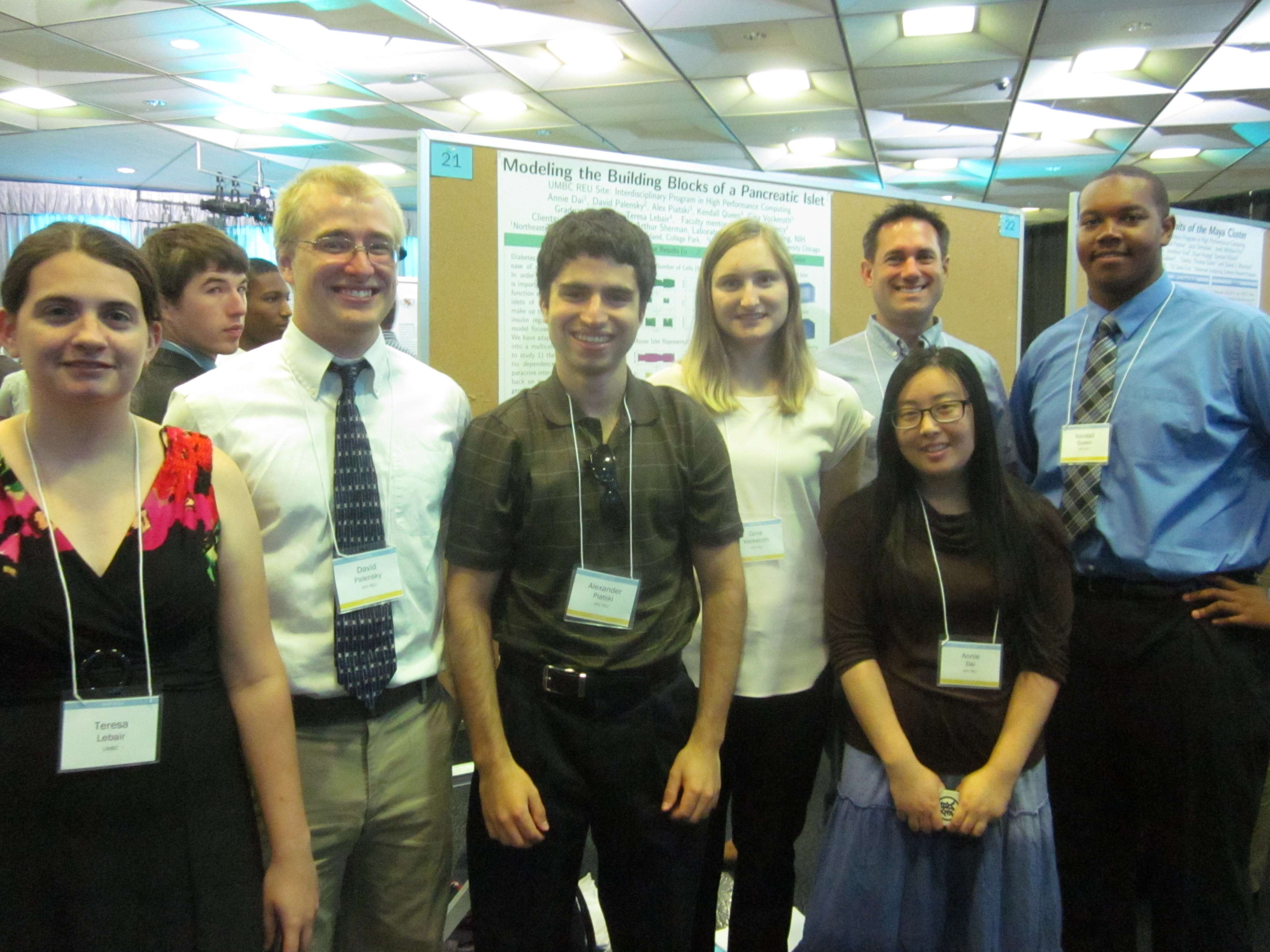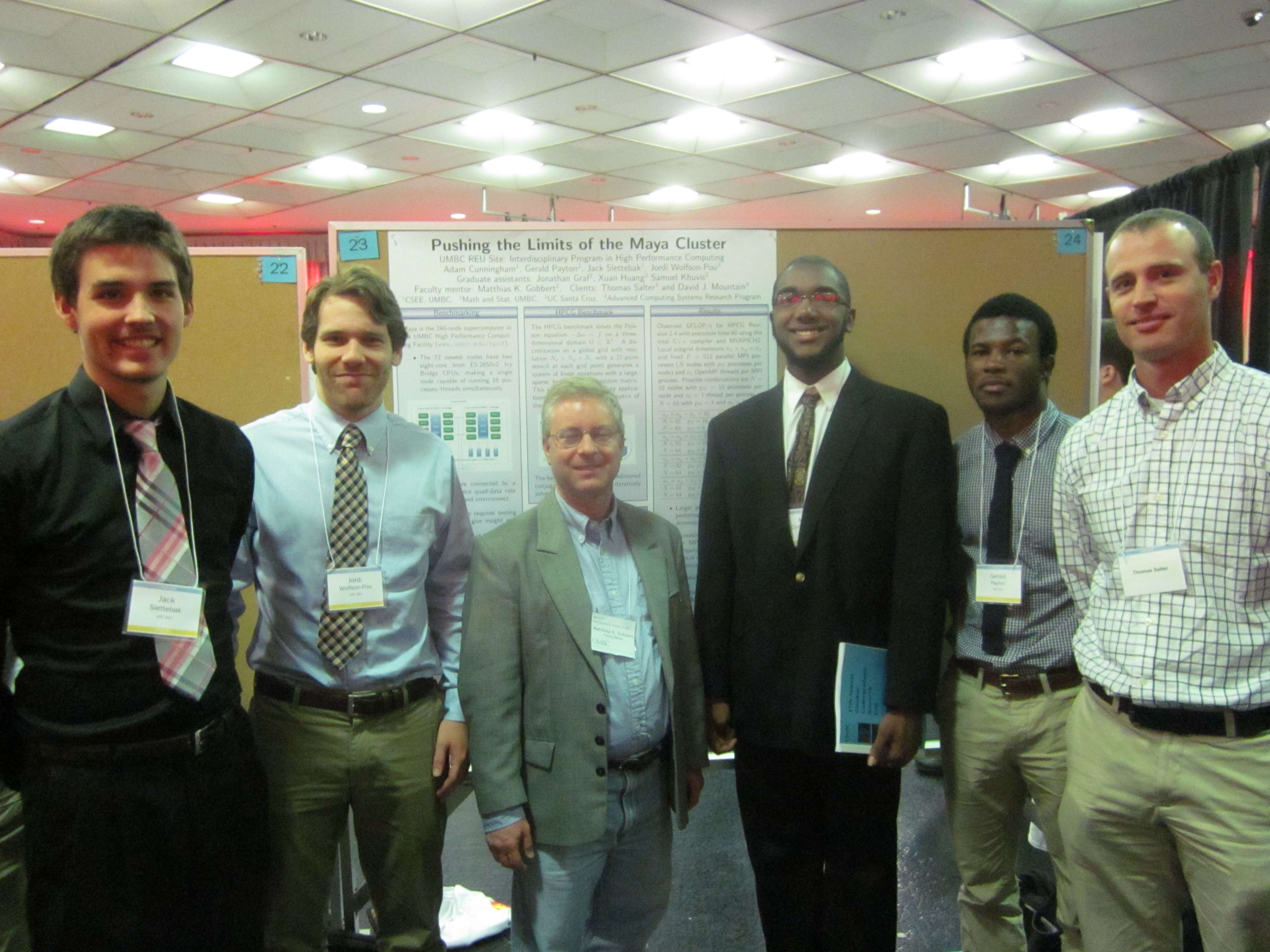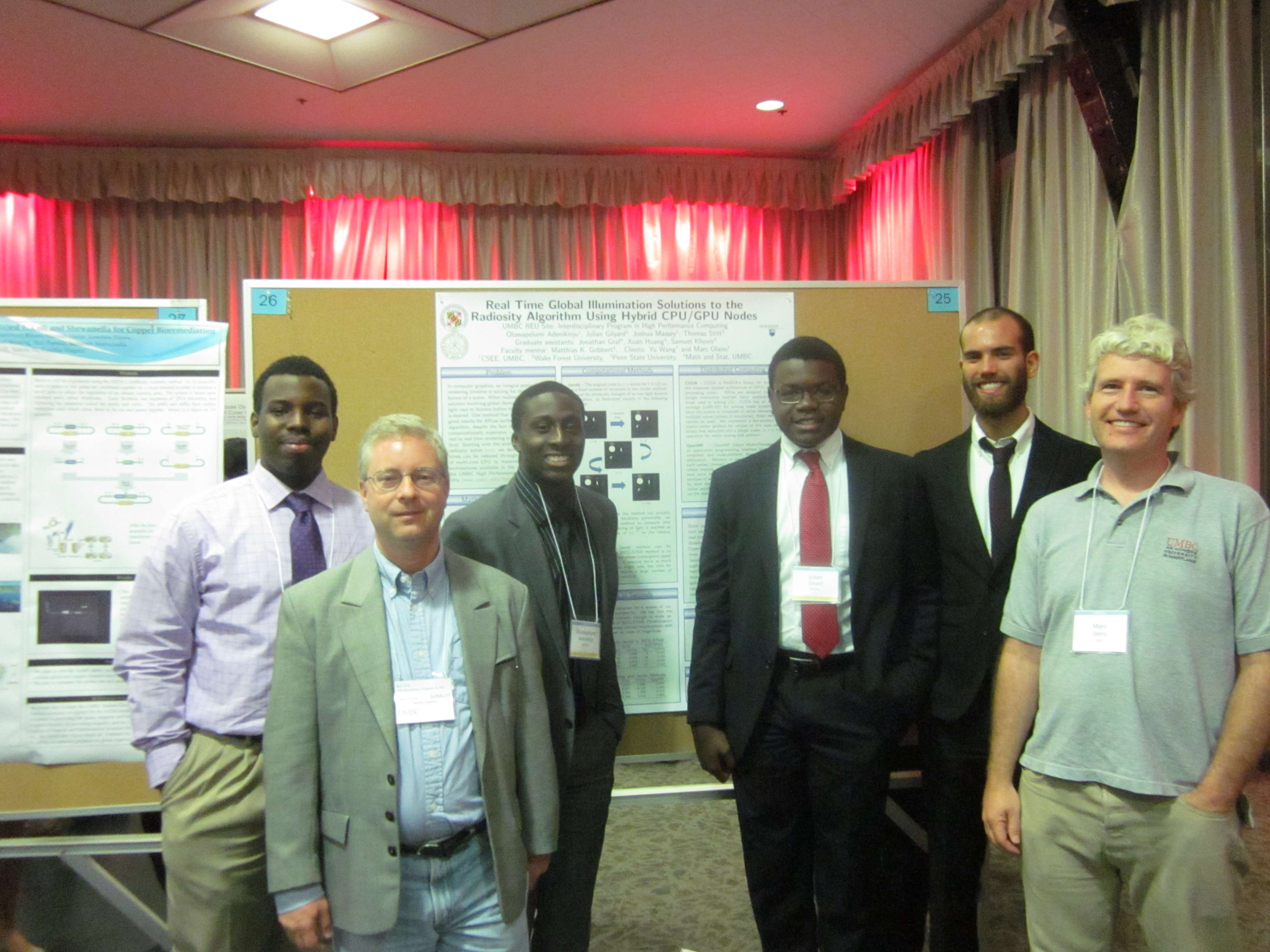This page contains brief reports and photos of special events the REU Site hosted or participated in.
Welcome Meeting
Sunday, 06/15/2014, 05:00pm-07:00pm
All participants, graduate students, and PIs met over sandwich and soda. The teams formed and started the process of getting to know each other. Drs. Neerchal and Gobbert discussed the philosophy of the program, with its team building while learning parallel computing, research projects as team, and the integrated professional development program that teaches how to conduct research.


VIP meeting with Dr. Freeman Hrabowski, President of UMBC
Thursday, 06/19/14, 02:00pm-02:30pm
Upon Dr. Hrabowski’s arrival, you can feel the excitement and anticipation to finally meet and greet the president of University of Maryland, Baltimore County. With his kind words of welcome and compliment, he emphasized how important it was for our country to have hardworking and dedicated individuals and especially those involved in the HPC REU summer 2014. Shortly after introducing himself he requested question from the HPC REU participants. Among those questions, one stood out that most expected a very different answer than the one Dr. Hraboski gave. The question was, “who are your role models?” He answer very simply and without deep thought or pause, “My students.” He saw his students and the students around him as the future of our world. He seems to be highly inspired by the aspirations that we all look to accomplish in our lives and inspiration propels him to do better for himself, his family, and this world.
— Kendall Queen
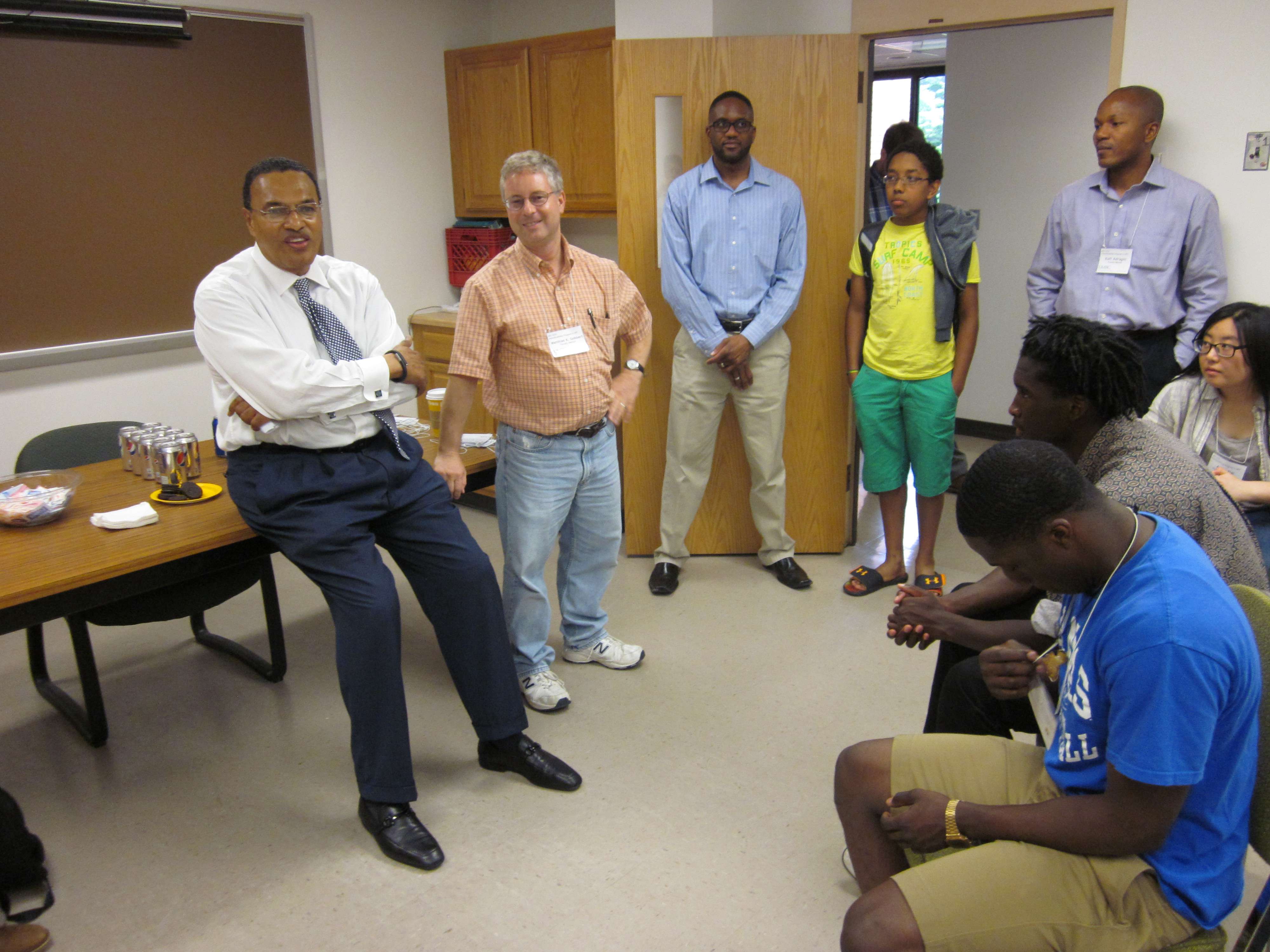
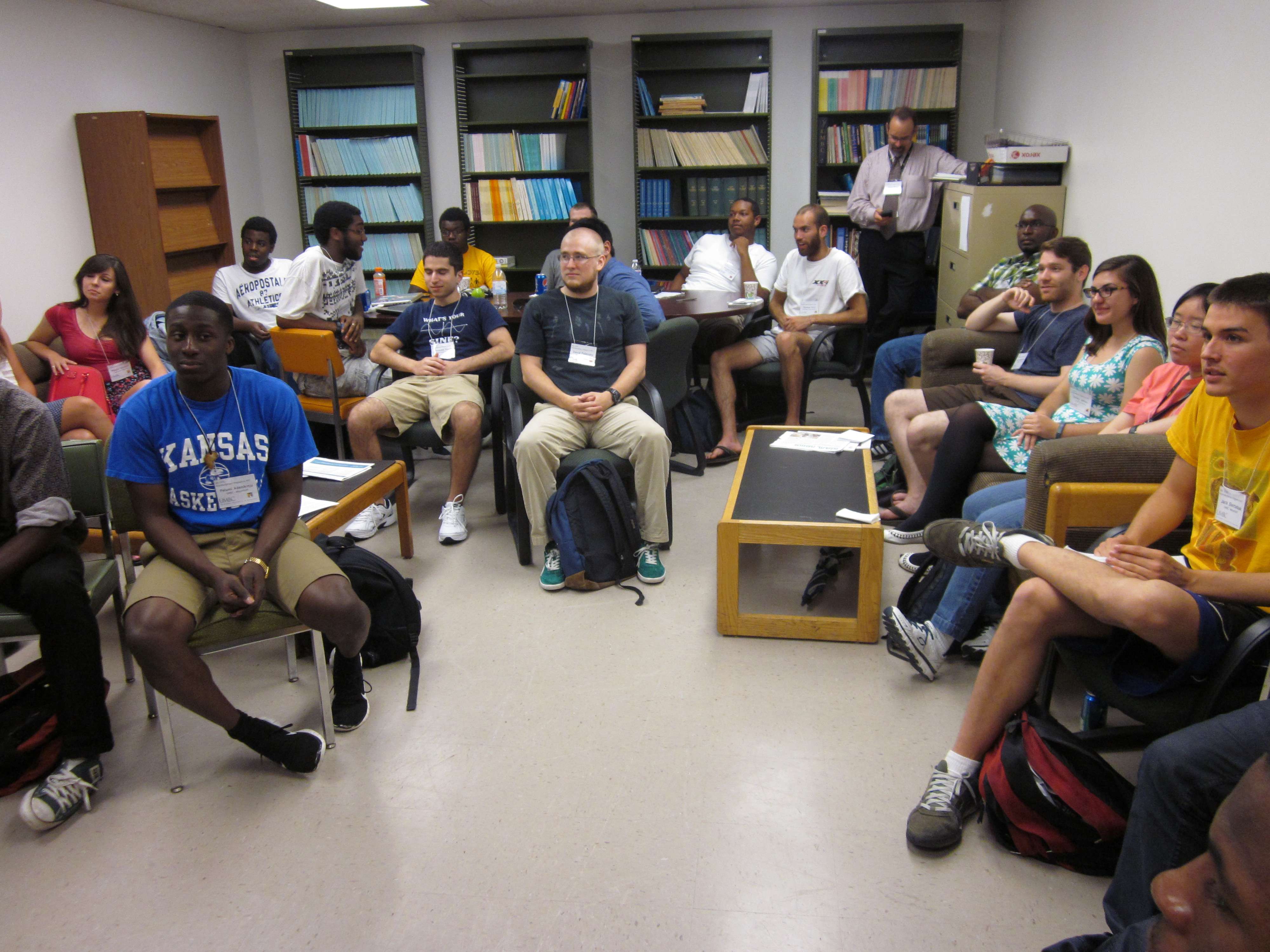
Presentations by project clients
Thursday, 06/19/14, 02:30pm-05:30pm
Before the formal presentations by the potential project clients, we had a coffee break in the lounge at 02:00pm to welcome all guests to the program. At the beginning of each talk, each presenter discussed very graciously their career choices, which gave interesting insight into options for research jobs.
The first presentation belonged to Dr. Ian Thorpe of UMBC’s Department of Chemistry and Biochemistry, and with it he set the bar high. He started out very simple. He produced a nifty flowchart that had a process in mind: We use math and physics to create and run computer simulations that ultimately provide insight into chemical and biological processes. And then things got more complicated. He hopes to be able to efficiently (and effectively) identify motional correlations in proteins, using many tests, including Generalized Correlation Coefficients, and Distance Correlation Coefficients.
The second presentation was given by Mr. Samuel Khuvis, alongside his mentor, Dr. Matthias Gobbert. Samuel, in a quiet but intellectual demeanor, proceeded to wow the crowd with a complex presentation of parallel computing on maya. He showed us data, mentioned its limitations, as well as the sheer amount of recent changes, and proceeded to describe our task. We were to compare our results to the previous ones on C/MPI and Matlab, and explain the discrepancies. We were to extend the study to 3-D, and extrapolate a conclusion to compare to those found in 2-D testing. We were to attempt to use GPU’s with Matlab, C, and C/MPI. And much more. This was one heck of a project.
When Dr. Marc Olano confessed to his love of theatre, no one was surprised. Throughout his performance, he held the stage with humor and passion, radiating his excitement for radiosity. He proposed a very interesting idea that went against popular opinion. Rather than using the standard of Monte Carlo Integration for graphic rendering, he wondered if the ability to parallelize Radiosity (a rival rendering technique) would result in faster frame rates at real-time, and as a result would allow improvements to real-time simulations. He proceeded to describe the linear algebra behind the calculations, and provided examples of its effect, such as the Cornell Box. Before any of us could ask how this would be done, his TA, Ms. Yu Wang, took the stage and described the advantages of GPUs in parallel computing. Overall, it was a very interesting presentation of an equally compelling project.
The final presentation was given by our own mentor Dr. Neerchal, on behalf of his biologist acquaintance. Dr. Neerchal’s project pertains to the distribution of ribosomal proteins of a cofactor phenotype. The talk was actually very informative, as we learned about the Wilcoxen Rank Sum Test, hypothesis testing, and optimal non-bipartite matching. Overall, it was very interesting to not early learn about the biology behind ribosomal distribution, but also to learn so much about the statistical research procedure. Overall, the project asks a team to write code in R that will test whether or not two samples are (sufficiently) different from each other regarding their distributions. It was a fantastic ending to the first presentation day. I look forward to hearing the rest next week.
— Alex Piatski
- 02:30-03:00 Dr. Ian Thorpe, Department of Chemistry and Biochemistry, UMBC
- 03:00-03:30 Samuel Khuvis and Dr. Matthias K. Gobbert, High Performance Computing Facility, UMBC
- 03:30-04:00 Coffee break
- 04:00-04:30 Yu Wang and Dr. Marc Olano, Department of Computer Science and Electrical Engineering, UMBC
- 04:30-05:00 Dr. Nagaraj K. Neerchal, Department of Mathematics and Statistics, UMBC



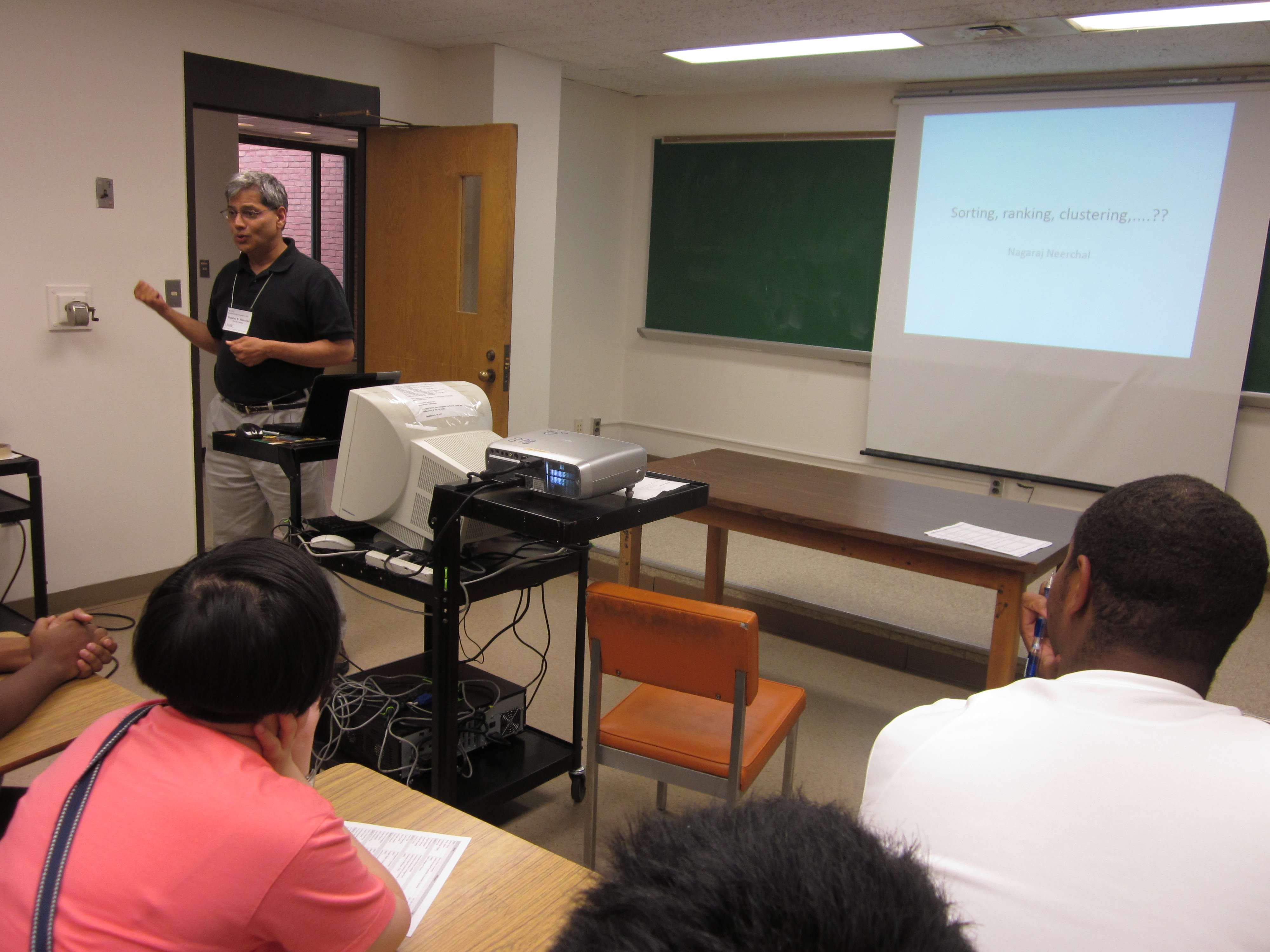
- 06:00-08:00 We had dinner with the clients at Hunan Manor in Columbia. We all learned some surprising things about all participants.
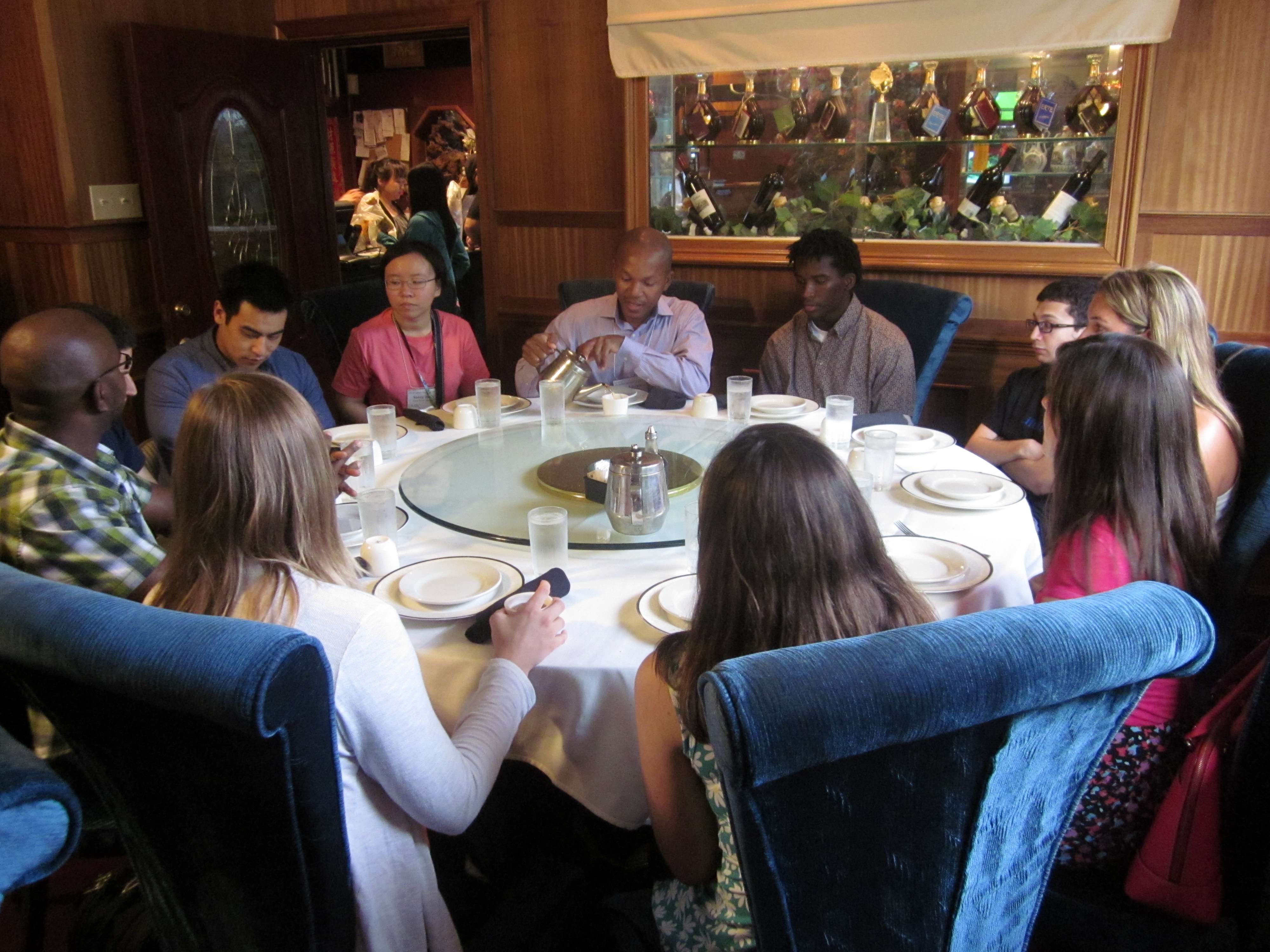
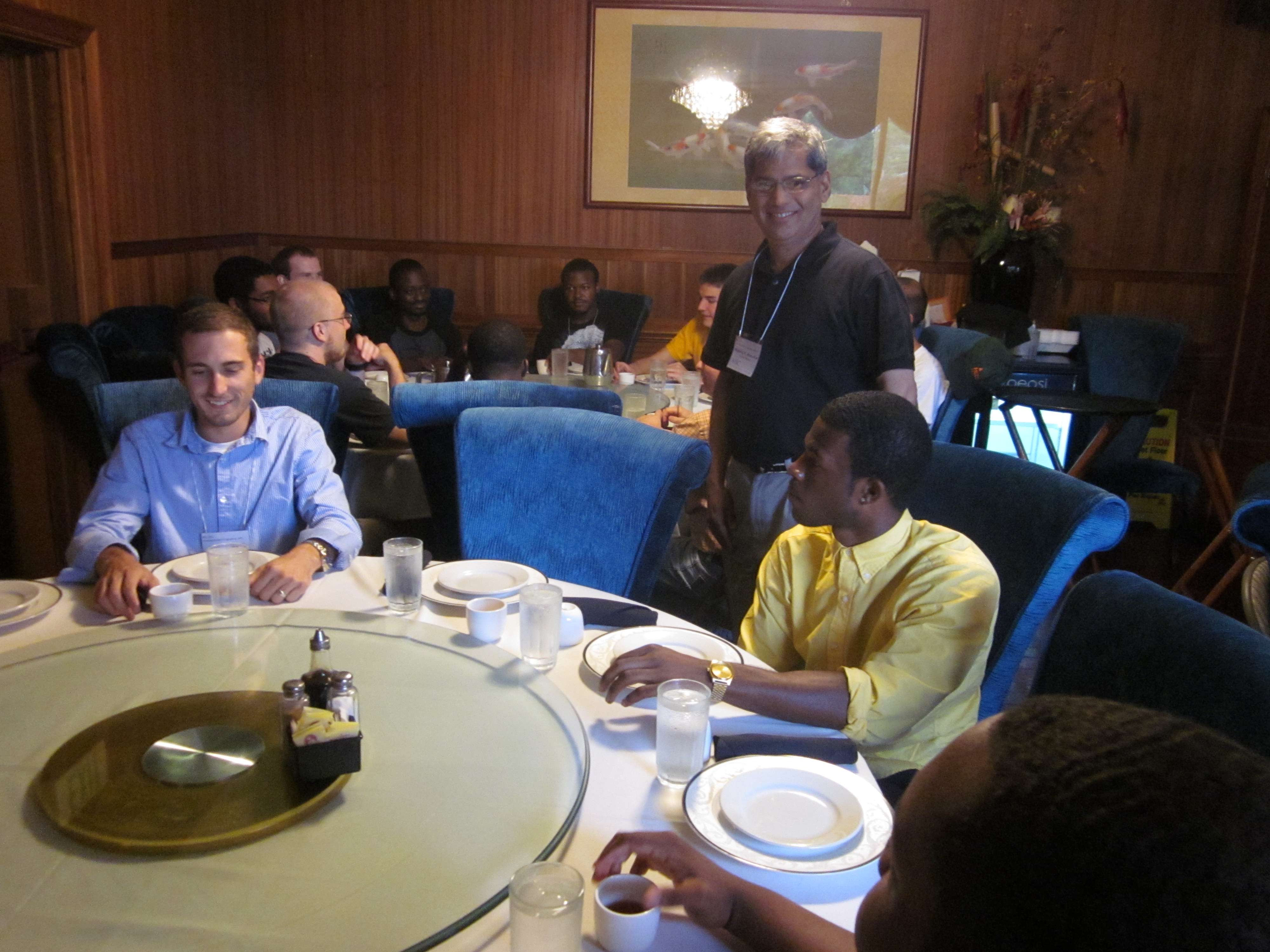
VIP meeting with Dr. Karl Steiner, Vice President for Research
Thursday, 06/19/14, 05:00pm-05:30pm
Karl Steiner, Vice President for Research at the University of Maryland, Baltimore County (UMBC), visited the High Performance Computing REU (HPC-REU), introducing himself between project presentations to current research participants. Mr. Steiner reminded the REU participants of their important role as technology students in an increasingly technology dominated world, emphasizing the benefits of participating in an REU that focused on high performance and statistics in computing. He also outlined the other opportunities that are available to UMBC students and researchers. In particular, he discussed the university’s excellent position at the center of the technological hub along the greater Baltimore-Washington area, pointing out that Baltimore had the most technology jobs of any city in the nation. In the same vein, Mr. Steiner pointed out that the Baltimore-Washington corridor was unique in being home to both large, government organizations (NSA, NIST, etc.) and cutting-edge, private industries (Lockheed Martin, Northrop Grumman, etc.).
— Jack Slettebak
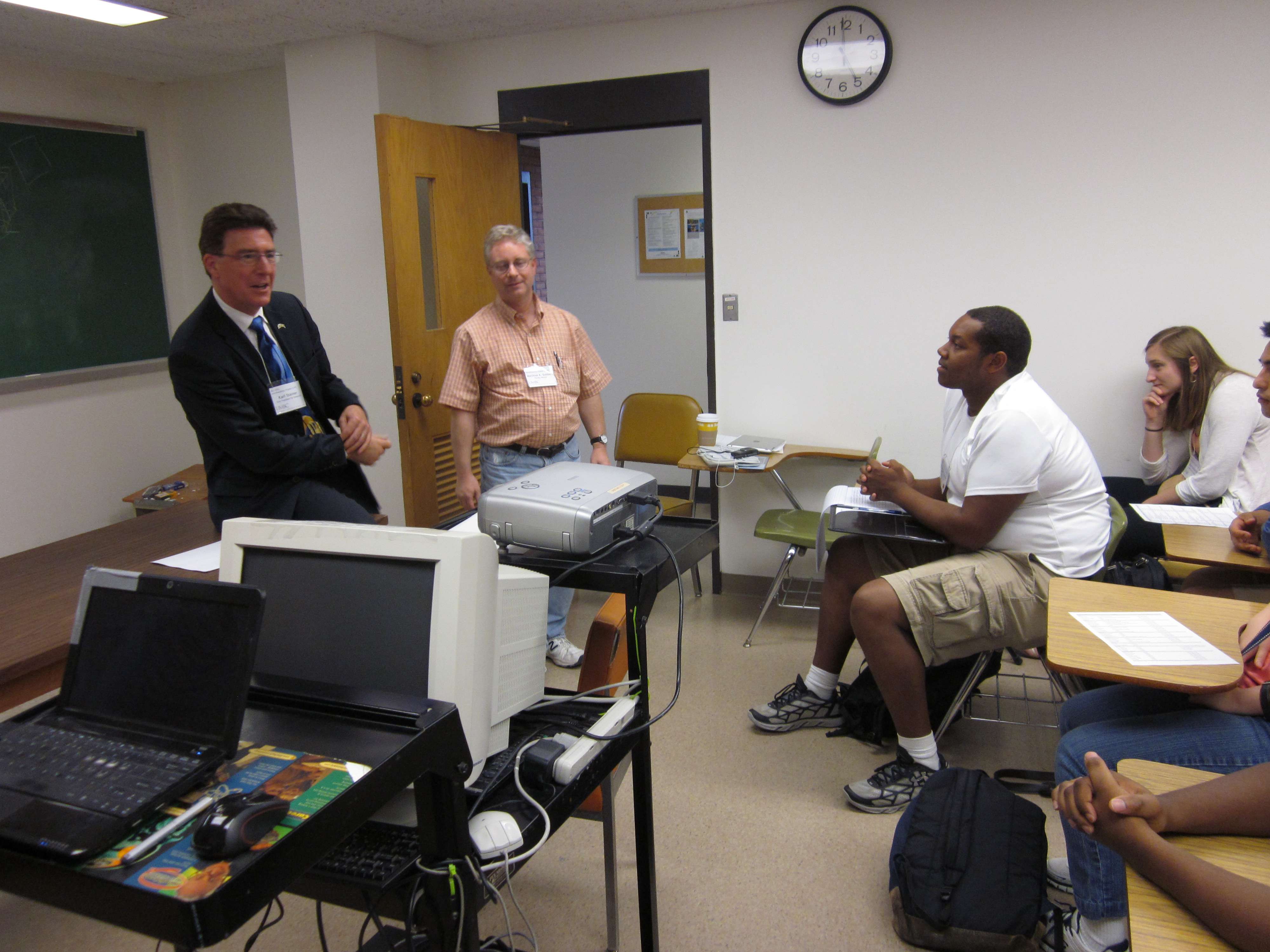
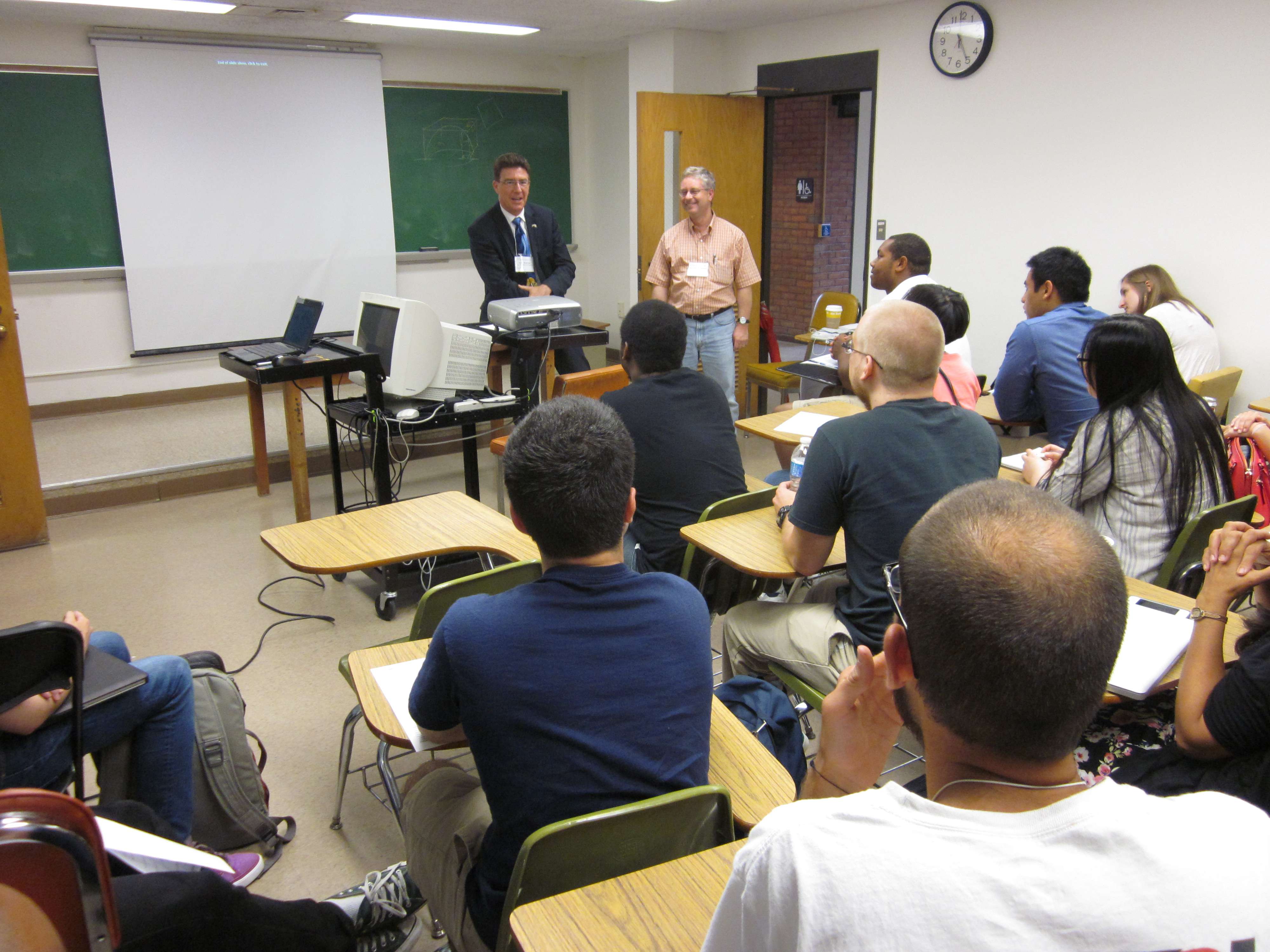
Presentations by project clients
Thursday, 06/26/14, 02:00pm-04:30pm
The first presentation of the day was given by Dr. Thomas Salter of the NSA’s Advanced Computing Systems Research Program, with his colleague Dr. David Mountain also in attendance. Dr. Salter’s proposed project involved testing benchmarks on Maya cluster to characterize its performance on a variety of tasks. His talk was quite informative, detailing how the preferred metrics of benchmarking have changed over time, ranging from clock speed to performance on a given level of power consumption. A computer system might perform much better at certain tasks than others given its specific architecture, so several benchmarks are required to better characterize its performance. Perhaps the most surprising part of the presentation was that the conjugate gradient method for solving special systems of linear equations is now being used a benchmark: this is precisely what we had been working on in class!
The second presentation was by Dr Amita Mehta from the Joint Center for Earth Systems Technology. The main objective of the project she is working on is to assess the impact of climate variability, assessing the change of water and their impact on agricultural production in the Missouri River Basin (MRB) using climate model downscaling and SWAT simulations. She expects from the REU researchers to implement code for visualizing climate model data from downscaling and SWAT simulations; implement R code for running climate downscaled algorithms, and feeding the data to SWAT for simulations; and parallelize these if possible.
The third presentation was by Margarett Watts and Arthur Sherman from the National Institutes of Health. This team of researchers focuses on modeling paracrine interaction in pancreatic islets. They are trying to come up with a model (tri-hormonal model) where the alpla-cells, beta-cells and delta-cells talk to each other in order to synchronize their activities. Following is the role of each cell category. The alpha-cells secrete glucogon to raise the glucose level back to the “accepted” range. The beta-cells secrete insuline. The delta-cells secrete somatostatin to decease the glucose level back to the “accepted” range. The clients expect us to model an islet with different proportions of apha-cells, beta-cells and delta-cells; investigate different arrangement of the islet in mouse versus humans; and answer the question: “Do paracrine interactions tame heterogenity?”
Dr. Brian Smith of the Maryland Department of Natural Resources gave another notable presentation covering the task of assessing water quality in the Chesapeake Bay. The Chesapeake Bay is actually America’s largest estuary, and the Chesapeake Bay watershed encompasses part of six states. After a discussion of the Bay’s characteristics, Dr. Smith deftly introduced the various factors constituting what we think of as water quality, such as water clarity, salinity, and the balance of nutrients in the water. Several programs are in place to monitor these factors, some by sampling the water periodically and others taking continuous readings. With significant amounts of data having been collected, the next natural step is to further explore the data and statistically analyze it, providing the impetus for a substantive project. Before closing, Dr. Smith divulged that there was also demand for creating a tool to visualize the water quality data, setting up the possibility of another type of interesting project.
— Moise Mouyebe and Daniel Xie
- 02:00-02:30 Dr. Thomas Salter and Dr. David Mountain, Advanced Computing Systems Research Program
- 02:30-03:00 Dr. Amita Mehta, Research Assistant Professor Joint Center for Earth Systems Technology (JCET) and Geography and Environmental Systems, UMBC
- 03:00-03:30 Coffee break
- 03:30-04:00 Dr. Margaret Watts, Research Mathematician, and Dr. Arthur Sherman, Research Mathematician, Laboratory of Biological Modeling, National Institutes of Health, NIDDK
- 04:00-04:30 Dr. Brian R. Smith, Program Manager, Monitoring Integration, Resource Assessment Service, Maryland Department of Natural Resources (DNR)
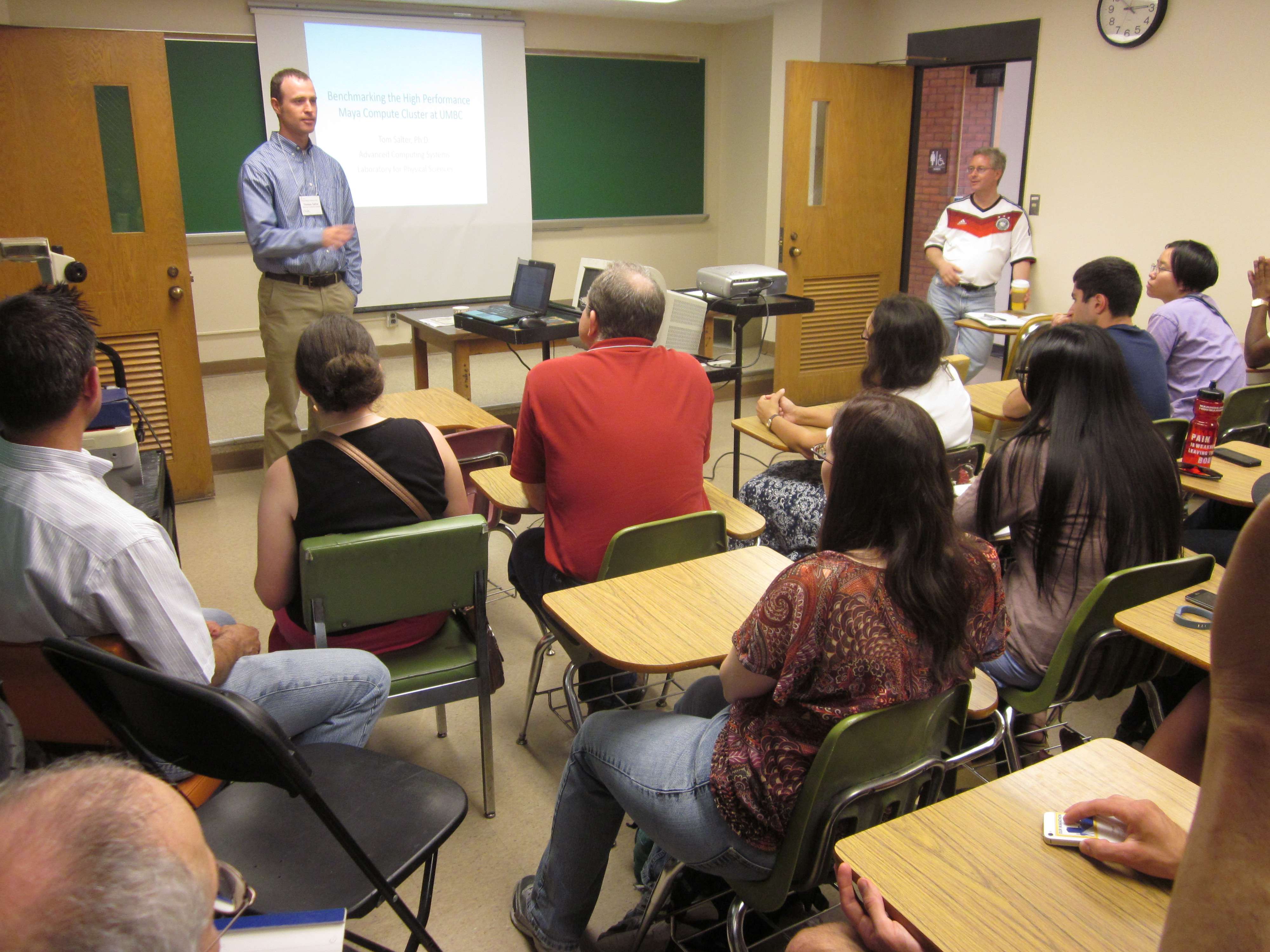
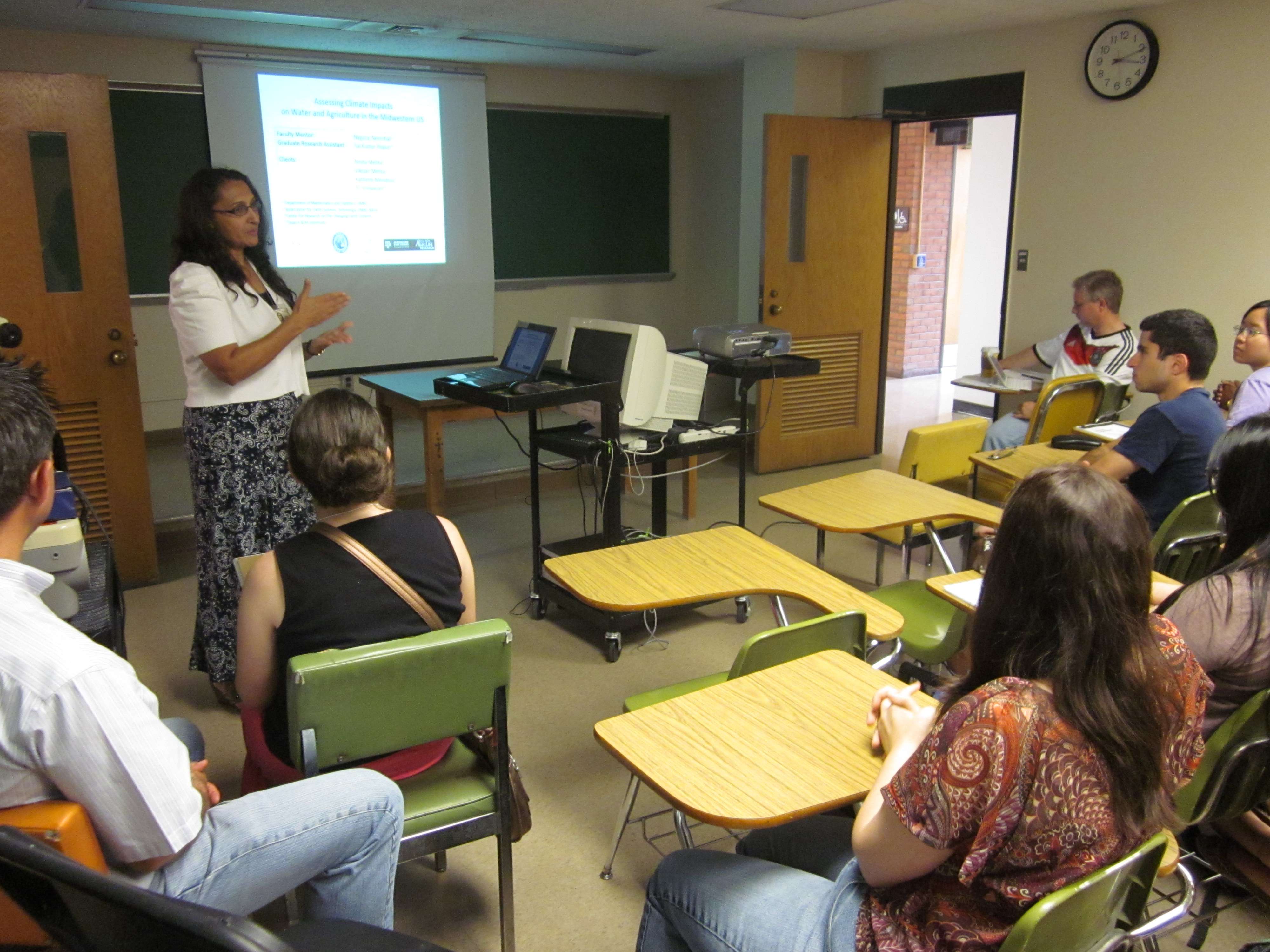
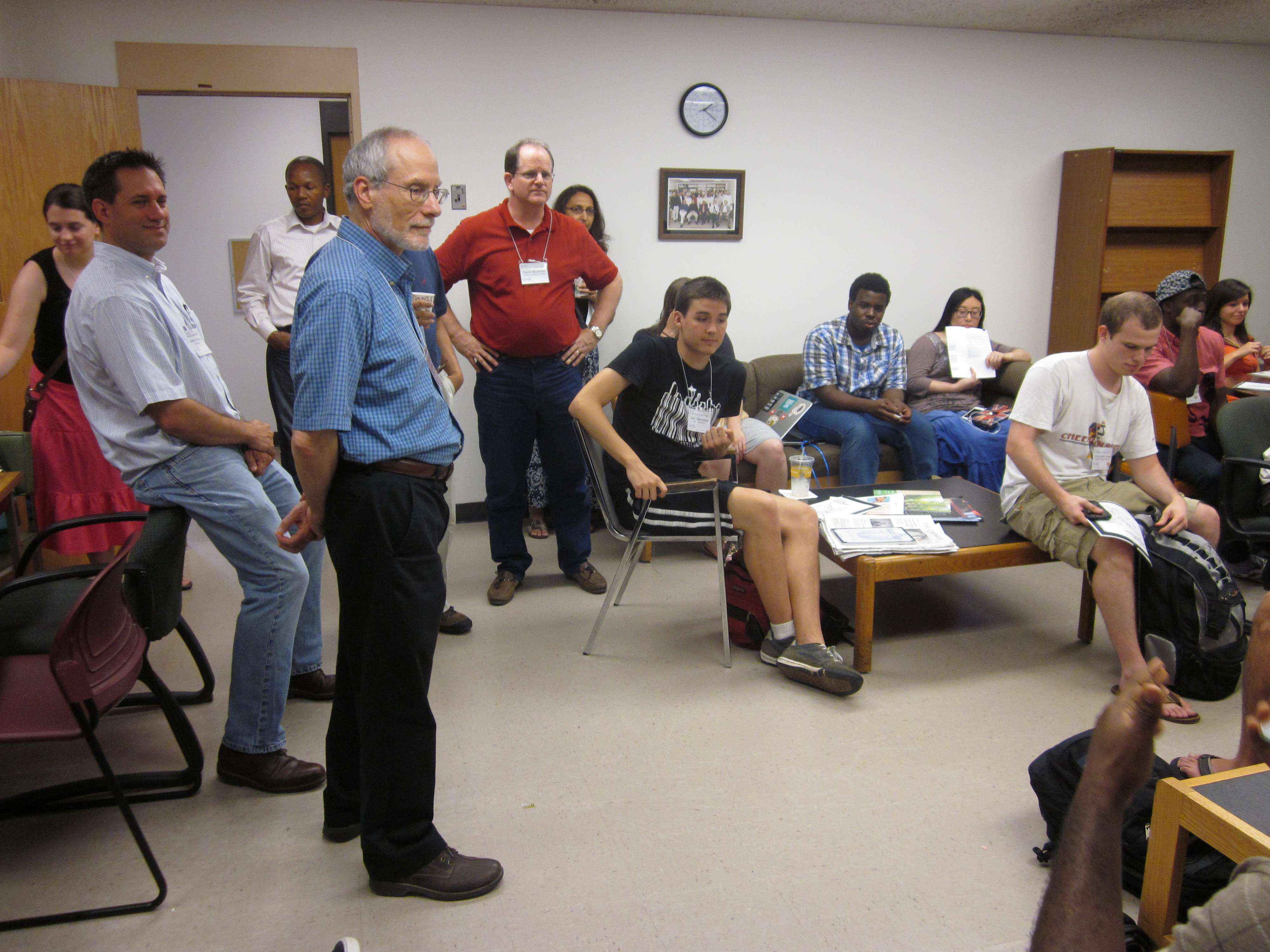
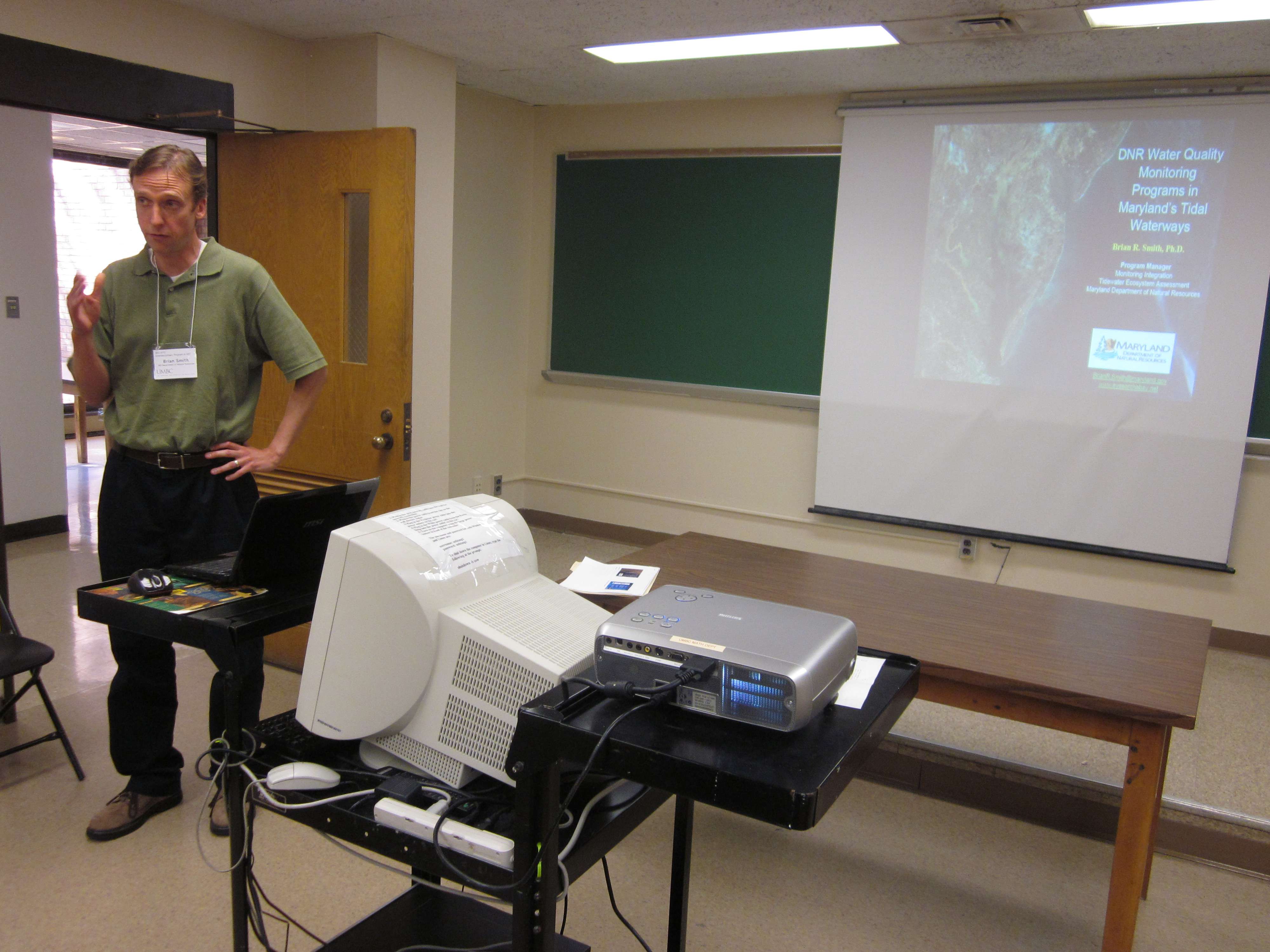
- 05:30-07:00 We had dinner with the clients at Paradise Indian Cuisine in Woodlawn. We all learned some surprising things about all participants.
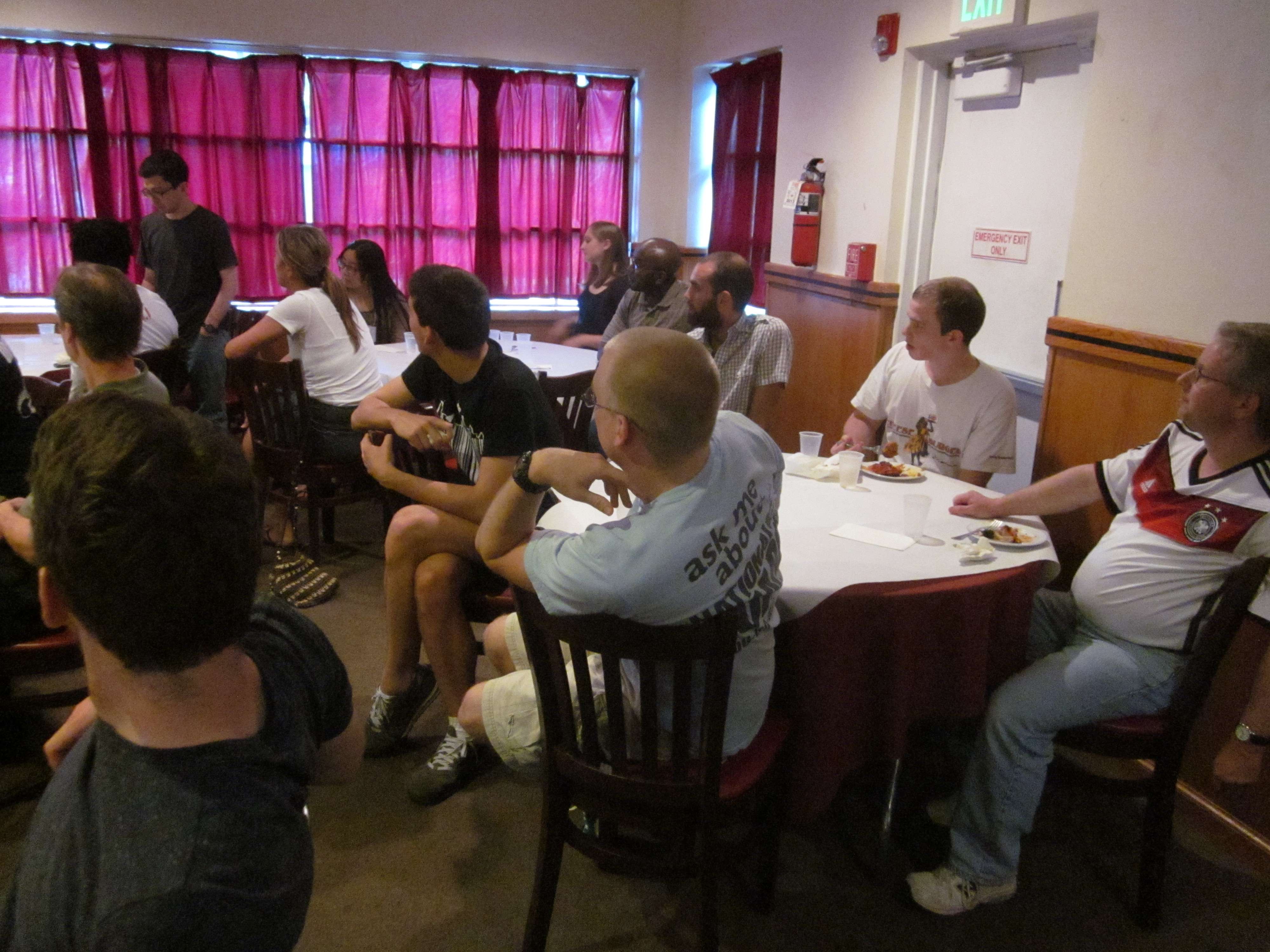

Professional development workshop with Kathy Sutphin, Assistant Dean of CNMS
Wednesday, 07/02/14, 04:00pm-05:00pm
Kathy Sutphin, the Assistant Dean of the College of Natural and Mathematical Sciences at UMBC, came to visit us and spoke about her career path. She also talked about what a typical day looks like in her job, which includes writing many grants for the school to fund research. The main purpose of her visit was to introduce us to the Annual UMBC Summer Undergraduate Research Fest (SURF), in which we will all have a poster presentation at upon the conclusion of the REU. She provided us with helpful information on what to expect and how to prepare for SURF. We were given specific details about the event schedule, how to register, and the abstract submission deadline. Additionally, she advised us on general presentation tips, such as how to write, review, and submit an abstract, along with preparing the presentation and finally presenting research. This information will help us all with not just the SURF presentation, but also other scientific presentations we may attend. We look forward to completing our research projects and having the opportunity to present at the Summer Undergraduate Research Fest.
– Lauren Gomez
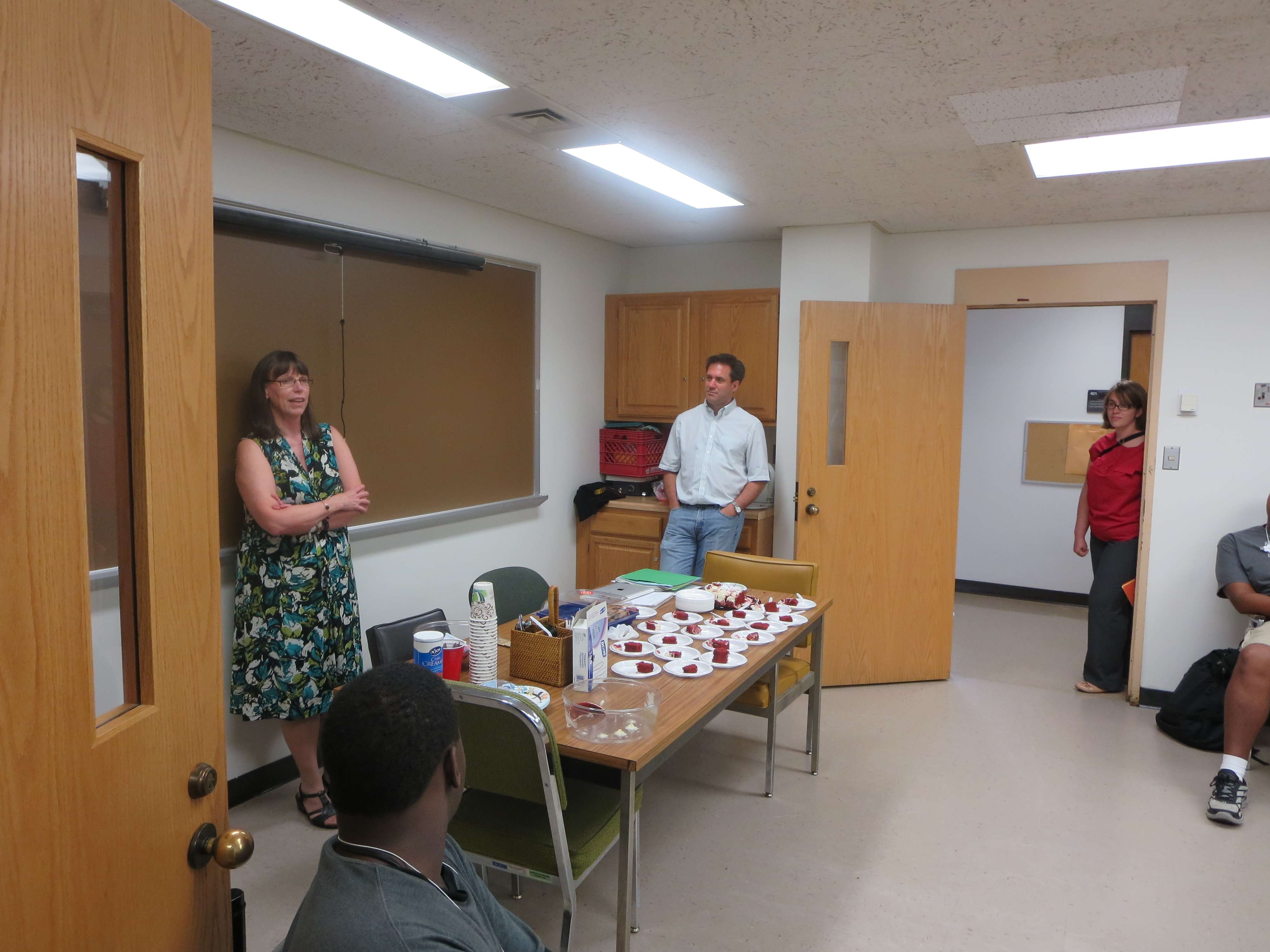
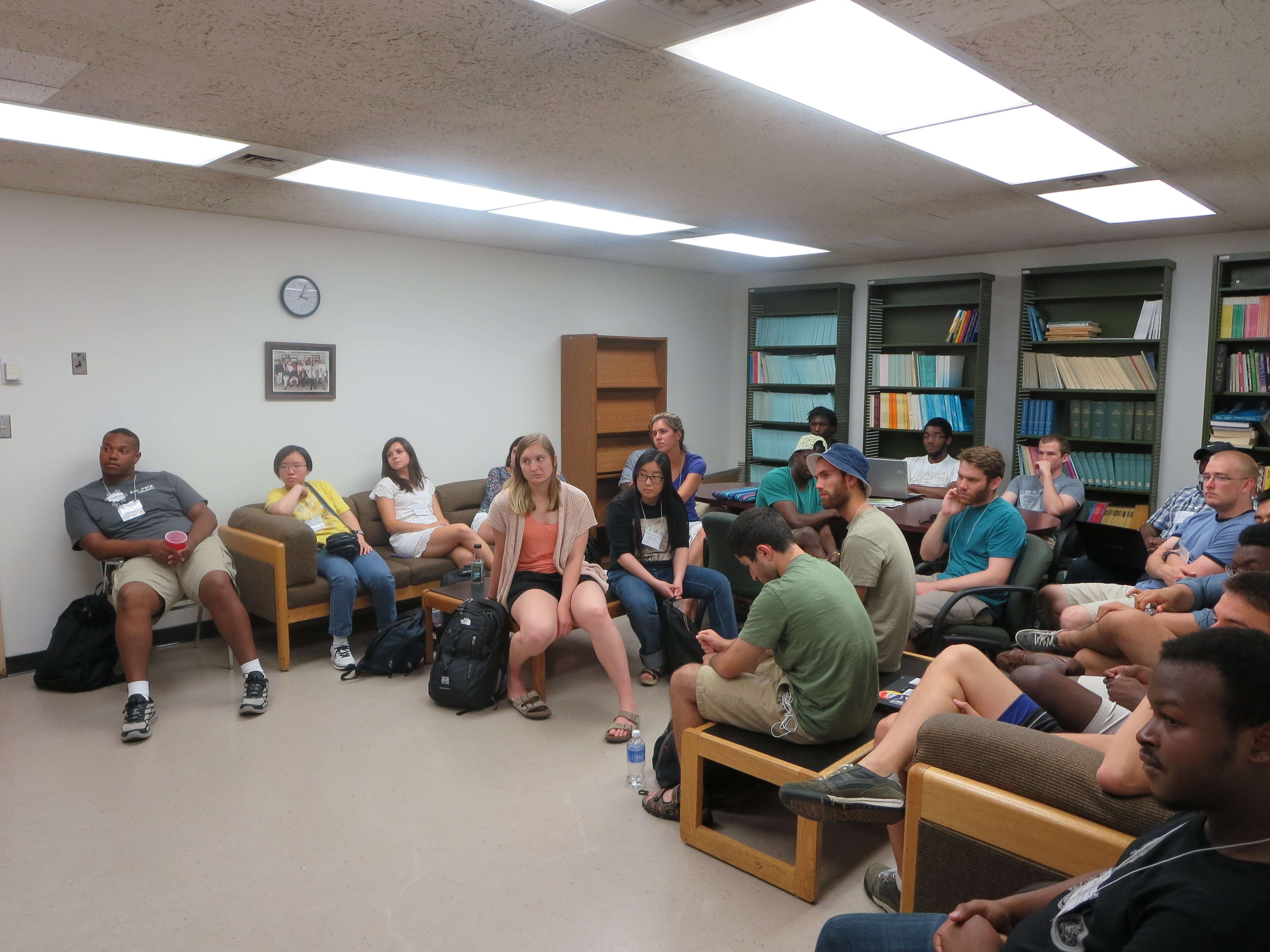
VIP meeting with Dr. William LaCourse, Dean of CNMS
Tuesday, 07/08/14, 09:00am-09:30am
On Tuesday July 8th Dean of Natural and Mathematical Sciences, Dr. William LaCourse addressed the group of HPC students regarding the operations and responsibilities of his positions. While he visited, he spoke about his previous interest and his experience at UMBC. Dr. LaCourse has been at UMBC for over 20 years and plans to continue to teach classes even as a Dean. He spoke with pride about the intellectuality and breadth that the College of Natural and Mathematical Sciences provides. In his tenure as Dean, he has attempted to address numerous new teaching methodologies including new open learning environments. This open environment learning style has been coined Discovery and it encourages students to act in a collaborative atmosphere. Dr LaCourse answered questions from HPC students regarding his position and inspired students to continue the important research. Dr LaCourse’s chemistry background and enthusiastic personality made his visit pleasurable, entertaining and informative.
– Julian Gilyard
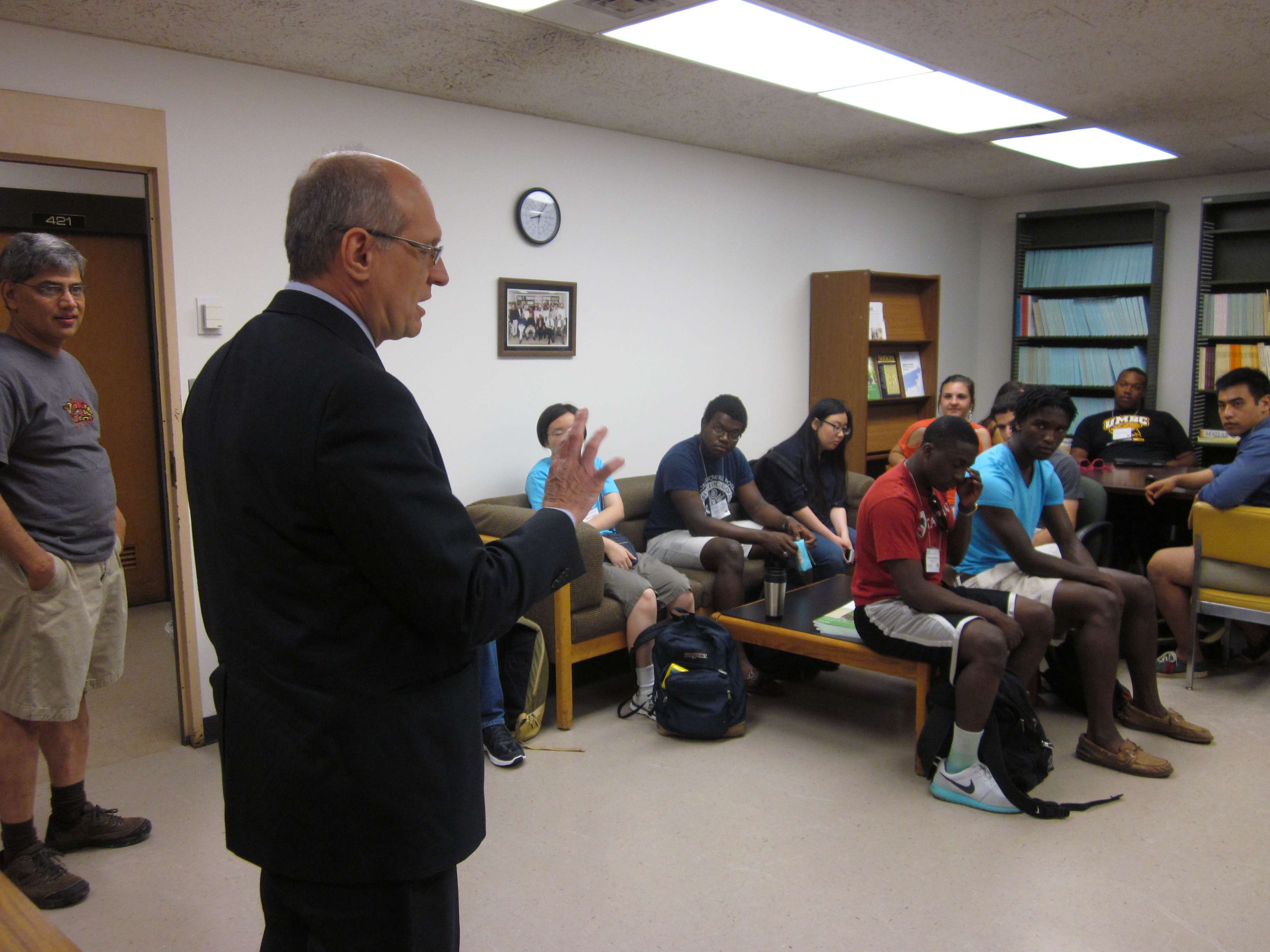
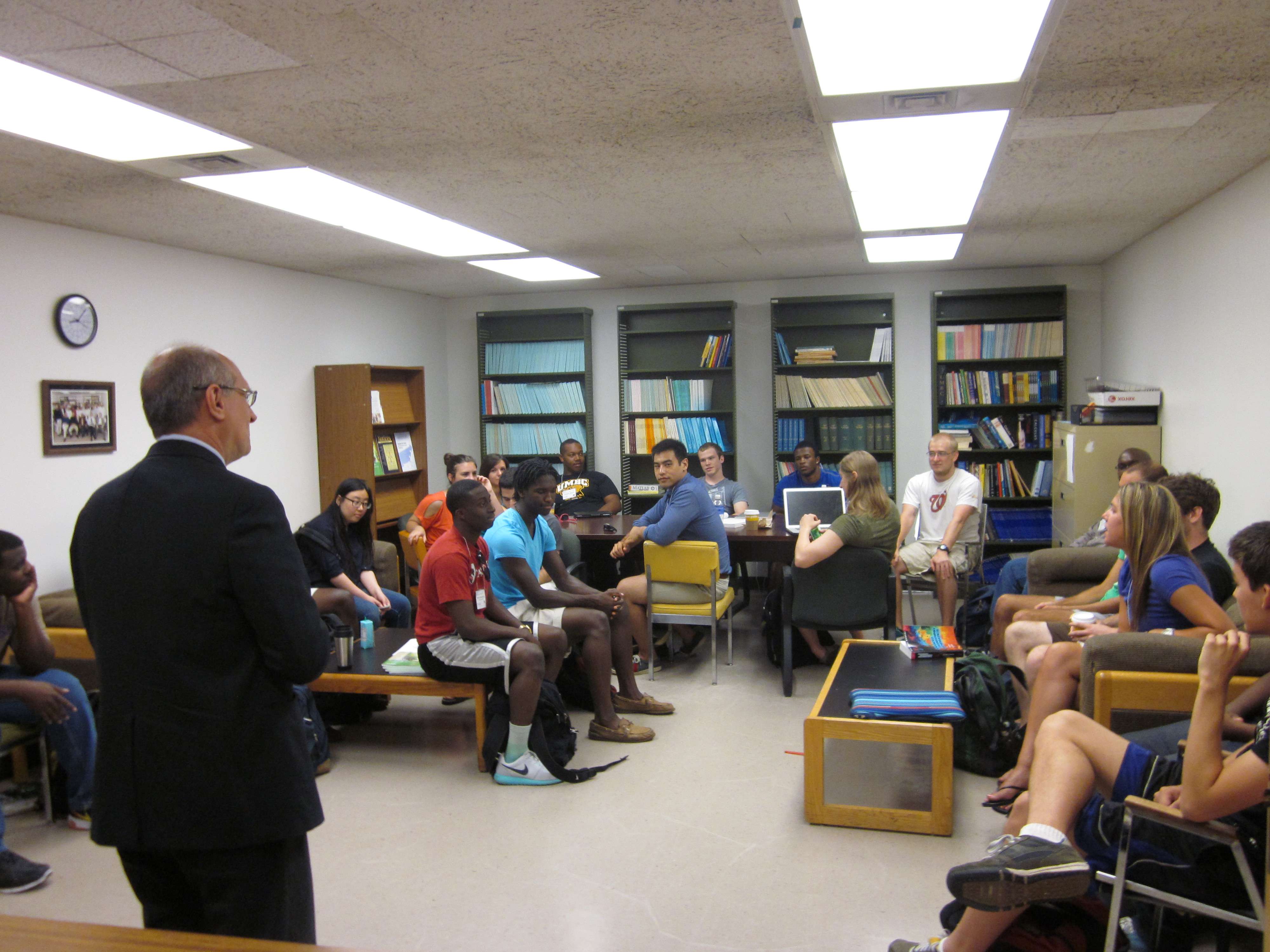
Professional development workshop with Dr. Janet Rutledge, Vice Provost and Dean of the Graduate School
Thursday, 07/10/14, 04:00pm-05:00pm
As the Dean of the Graduate School at UMBC and as one whohas herself attended graduate school, Janet C. Rutledge, Ph. D, was the ideal personto speak to the members of the HPC REU at UMBC about Graduate School andFellowship Applications. Dr. Rutledgeâs presentation began with a question tothe students about the purpose of obtaining oneâs B.S., M.S., and PhD, whichreally forced them to think about the path they were taking and why they weretaking it. She mentioned the difference between Graduate Degrees andProfessional Degrees and emphasized that there are many different options fordegrees to pursue after receiving oneâs B.S. The presentation then shifted itsfocus to the application process. Dr. Rutledge discussed funding and the differenttypes of funding that are available through the graduate school that oneattends and through outside institutions. She spoke about the differentcomponents of the application and emphasized that the Statement of Purpose isthe most important aspect of the application because of the control that theapplicant has over it. Some helpful advice was also given on obtaining strong lettersof recommendation. Dr. Rutledge also suggested that the students visit theschools they want to apply to and to ensure that the school is a good fit for theirinterests and style of learning. The students left Dr. Rutledgeâs presentationwith a better idea of how to go about choosing graduate schools to apply to andthe actual process of applying to them.
– Emily Jasien
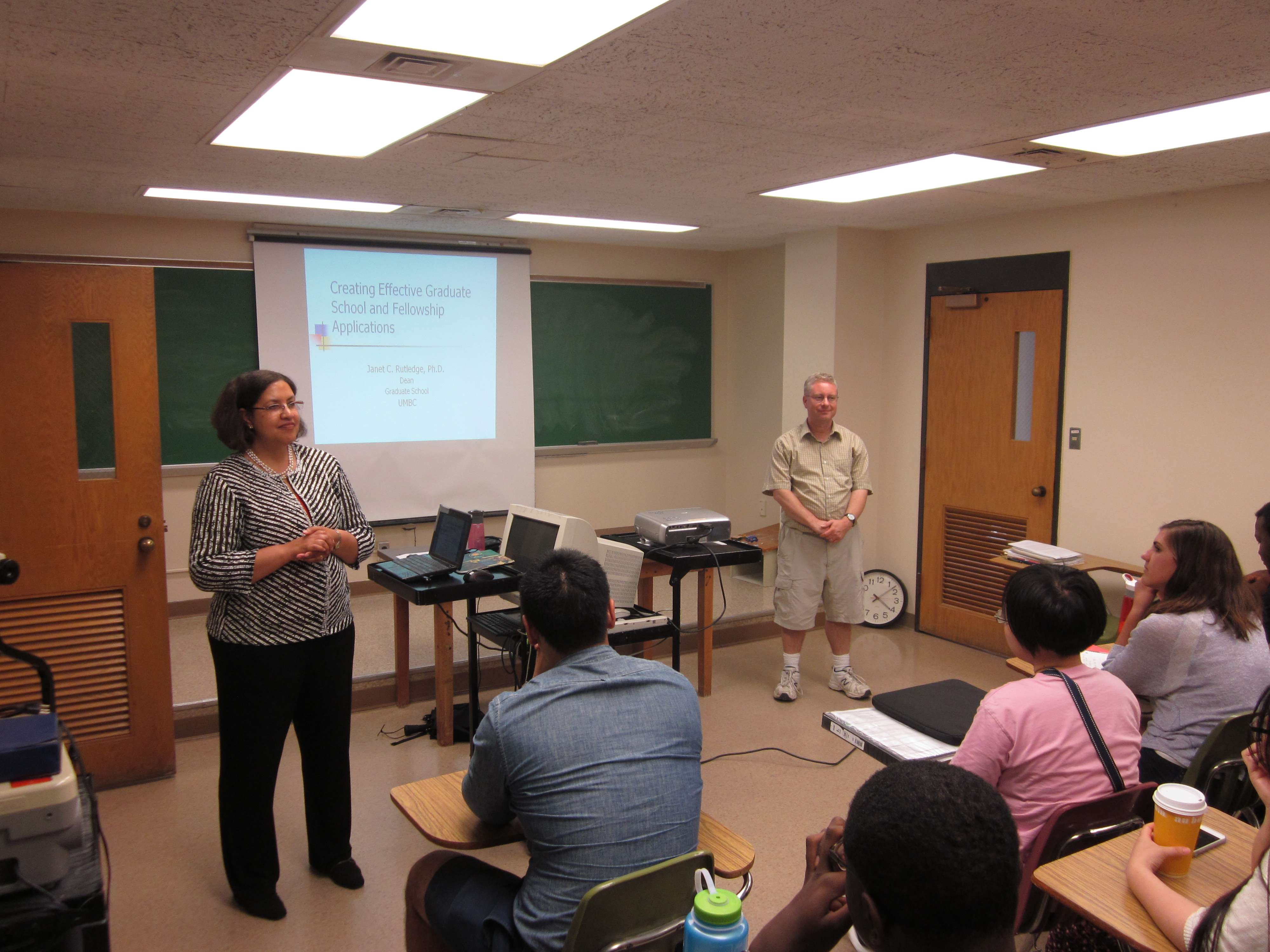
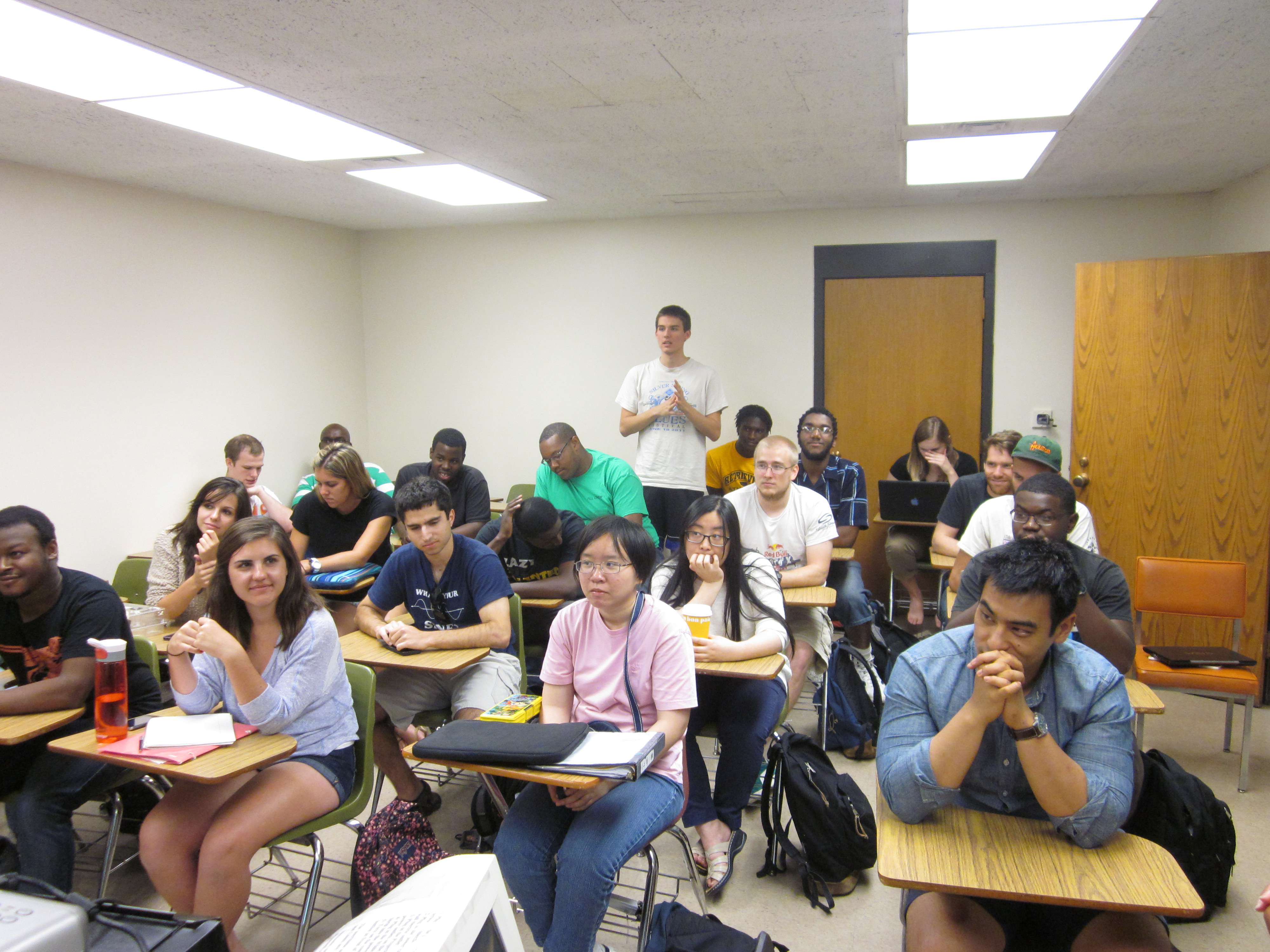
VIP meeting with Dr. Philip Rous, Provost of UMBC
Monday, 07/14/14, 09:00am-09:30am
Dr. Phillip Rous, the Provost of the University of Maryland Baltimore County paid a visit to the participants of the high performance computing research experience for undergraduates (HPC-REU) during the daily morning social activities. Dr. Rous shared his path to becoming provost and his own experiences concerning research in both his undergraduate and graduate careers. He also articulated on several points of action that he believed was important for undergraduate researchers to pursue in order to help prepare for graduate school and put themselves in optimal positions to conduct significant and important studies faculty members they desire to work with. Dr. Rous’s sound advice spoke to us all, as we look to him as a person of immense prestige.
– Gerald Payton

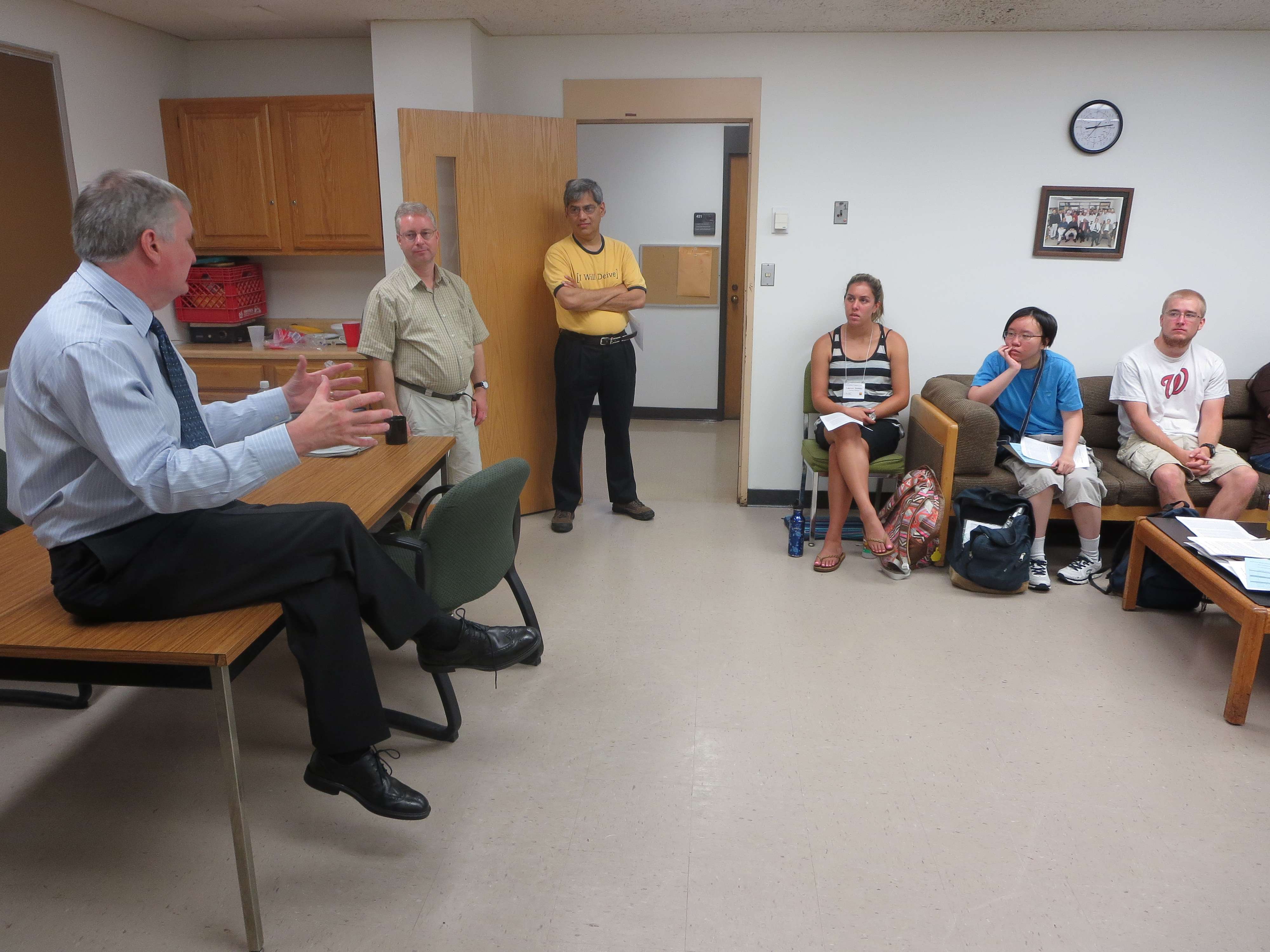
CIRC Workshop on the Intel Phi Accelerator by Intel
Monday, 07/15/14, 09:00am-04:00pm
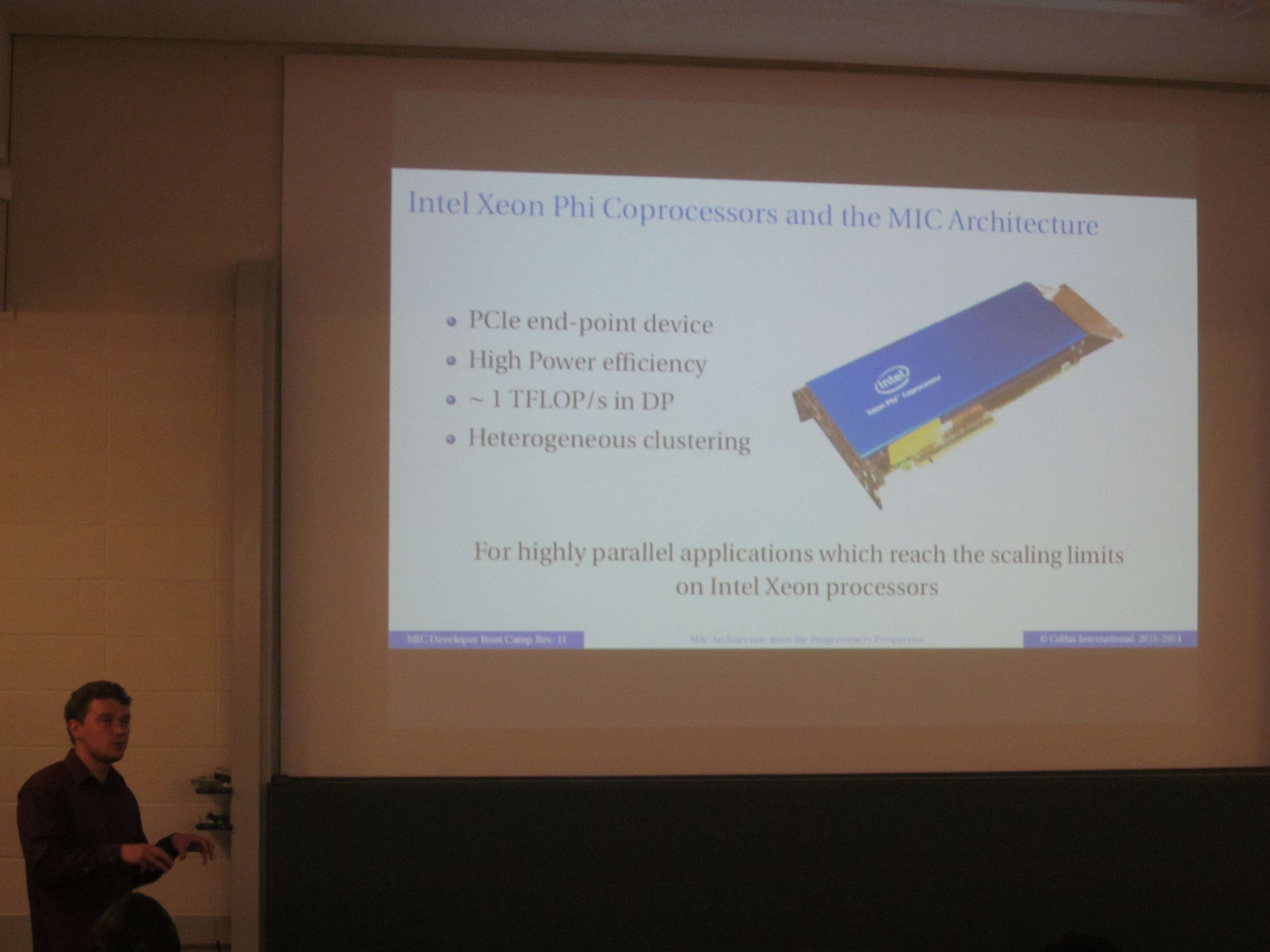

VIP meeting with Dr. Keith Harmon, Director of the Meyerhoff Scholars Program
Friday, 07/25/14, 09:00am-09:30am
Dr. Keith Harmon, the director of the Meyerhoff program at UMBC, paid a visit to the HPC REU during the morning social. After being briefed on each team’s project, Dr. Harmon discussed his career path. Dr. Harmon is a classically trained pianst, who knew he wanted to be a professor. He attend graduate school at Indiana University, Bloomington, where he became a mentor in a program for minorities. Through this program, he became very passionate about these types programs, and when a position became available in the Meyerhoff program at UMBC, he hopped at the chance. The Meyerhoff program has high standards for its students, knowing that their students can achieve these standards with the resources provided for them by the Meyerhoff program. The program provides a sense of community and support for minority students, where there might not be any. This support has led numerous minority students to go on and complete graduate degrees at some of the top ranking schools in the country. Through the Meyerhoff program, and other programs like it, Dr. Harmon hopes to diversify the workforce to more accurately reflect the American population and generate more representation, especially in STEM fields.
– Abigail Gartrell


Summer Undergraduate Research Fest (SURF)
Friday, 08/06/14, 09:00am-12:30pm


